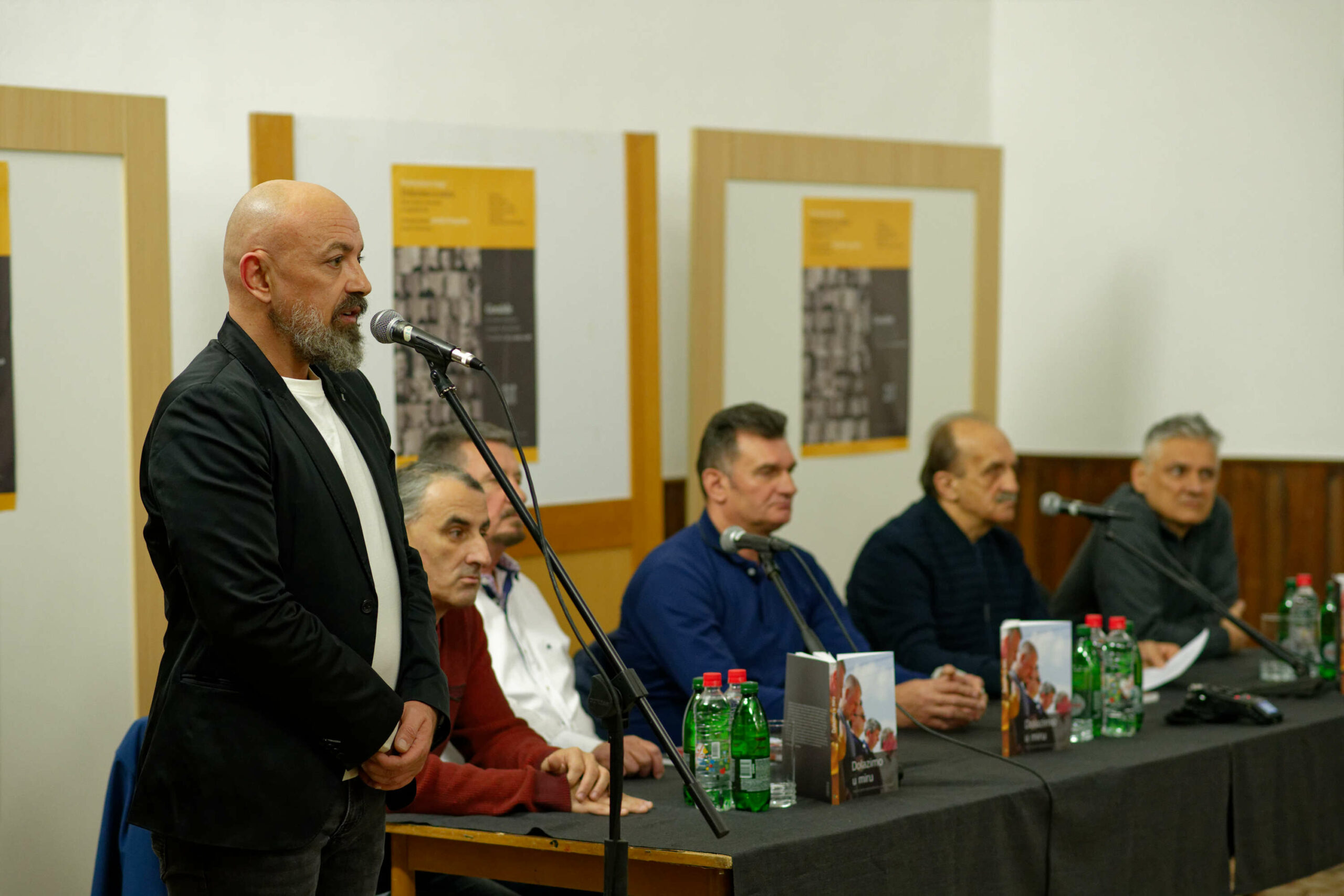On Monday, 17 March 2025 at 7 pm, the Culture Centre in Goražde hosted the presentation of the book We Come in Peace: War Veterans in Peacebuilding at the Youth Centre Hall, followed by the opening of the exhibition of photographs by Nenad Vukosavljević.
Slavko Klisura (Goražde) served as moderator for a discussion about the book with Đoko Pupčević (Šamac), Mirko Zečević Tadić (Brčko), Nenad Vukosavljević (Belgrade) and Suljo Đogo (Goražde).
At the very beginning, a moment of silence was held for the victims of the fire in Kočani, Macedonia, and then the director of the Goražde Culture Centre Jasmin Bešlija said a few welcoming words of introduction.
Speaking about more than two decades of working with war veterans on peacebuilding and the difficulties faced on the path of going from soldiers who used to shoot at each other to peace activists working together to ensure war never happens to anyone again, Nenad Vukosavljević pointed out:
When in 2002 we started with the “4 views” panels, the idea was to give former enemies an opportunity to see each other as people, and this was followed by numerous visits we did together with war veterans and thanks to them. The book We Come in Peace does not contain recipes, but it does outline the steps we took, including the missteps that are an inevitable part of the process. Dialogue between people who went to war against each other had never been recognised as needed, but when they met, they had the need to communicate, they wanted to talk. Together, we learned that crossing borders meant liberation. In many places, people who did not initially know who we were and why we had come would approach us later to thank us for coming. I have cried a lot in the past two months, since the student protests across Serbia began, but I have realised that I most often cried in the presence of these people, when people who had lost their loved ones met with veterans of armies that took them away. That too is liberating.
Đoko Pupćević, a war veteran of the Army of Republika Srpska, spoke about his engagement with peace activism:
Every visit to a site of suffering is emotional. Seeing the names and years of birth of those killed at the sites brings tears to your eyes. My heart constricts, I weep, it takes me a while to get back to normal. In the end, we are all just people. But we are people that also initiated peace.
For the Goražde native Suljo Đogo, this was not the first time he played host in his town, welcoming peace activists and war veterans. He contributed to a number of actions over the years, and at the book promotion, he said:
I joined the idea of the Centre for Nonviolent Action in 2015, and this was the first time I learned that the Army of Bosnia and Herzegovina had also run camps, I heard about it from a man who had been imprisoned in the Bijelo Polje camp near Mostar. He told me how after leaving the camp, he became a staunch Croat nationalist, but that a conversation with his neighbour, who had been imprisoned in the Heliodrom camp, changed him completely.
As a minor combatant and disabled war veteran, Mirko Zečević Tadić wanted to start a dialogue with those on the other side immediately after the end of hostilities. He spoke about this at the promotion of the book We Come in Peace:
We are the ones who have to change, to become better people, this is the only way we can leave a better future for the youth. I lost my youth in the war and I don’t want this to happen to anyone else ever again.
The residents of Goražde in attendance contributed emotional personal stories and expressed gratitude that a conversation about peace and peacebuilding was held at this very moment of social and political tensions.
The presented book collects the experiences gained by the Centre for Nonviolent Action over more than twenty years of working with war veterans and has two parts: one is focused on the potential of war veterans for peacebuilding and the experiences gathered in this field, and the second part focuses on the people who make this work possible.
The book chapters were contributed by Amer Delić, Ivana Franović, Nedžad Novalić and Nenad Vukosavljević.
The editors were Ivana Franović, Davorka Turk and Martina Fischer.
The electronic edition of the book can be downloaded for free from our website and print copies are available to visitors in our offices in Sarajevo and Belgrade.
The accompanying photography exhibition will be on display until 24 March 2025. During the first two days after its opening, on 18 and 19 March, staff of the Centre for Nonviolent Action will be on hand to explain the context of the exhibition.
The photo gallery can be viewed HERE

